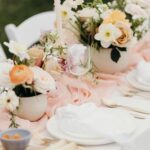Choosing the right attire for a wedding is crucial, and knowing what colors not to wear to a wedding is equally important. The significance of dressing appropriately for such a special occasion cannot be overstated, as it shows respect for the couple and their celebration.
Certain colors should be avoided when selecting wedding attire to ensure that the focus remains on the bride and groom. In this article, we will explore the importance of proper wedding attire and discuss why specific colors should be excluded from your wardrobe choices.
When attending a wedding, it is essential to adhere to traditional wedding attire etiquette. This includes avoiding certain colors that hold significant meaning in the context of weddings, such as white, black, and red.
Understanding the impact of these colors on the overall atmosphere of the event is key to making informed outfit choices. Let’s take a closer look at why these colors are typically discouraged in wedding attire and how they can potentially affect the couple’s special day.
In addition to understanding traditional wedding etiquette, it is also important to consider cultural and religious factors that may influence color choices for wedding attire. Different cultures and customs have unique perspectives on color symbolism, which can play a role in determining appropriate wardrobe options for guests. By exploring these considerations, we can gain insight into the broader significance of color selection in the context of weddings.
Traditional Wedding Attire Etiquette
When it comes to attending a wedding, dressing appropriately is crucial. Traditional wedding attire etiquette varies depending on cultural and religious factors, but there are also some universal guidelines that should be followed. One of the most well-known rules is avoiding the colors white, black, and red.
In many Western cultures, white is associated with the bride and should be reserved exclusively for her on her special day. Wearing a white dress or suit as a guest can be seen as an attempt to overshadow the bride, which is considered highly disrespectful.
Black is often associated with mourning and sadness, so wearing an all-black outfit can send the wrong message at a joyous occasion like a wedding. Red, on the other hand, is often seen as flashy and attention-grabbing, which has the potential to divert attention from the couple getting married.
It’s essential to remember that while avoiding these colors is generally considered good etiquette for wedding guests, there may be specific instances or cultures where these guidelines do not apply. Understanding cultural and religious considerations when it comes to color choices for wedding attire is crucial in ensuring that you show respect for the couple and their special day.
| Color | Reason to Avoid |
|---|---|
| White | Reserved for the bride; seen as an attempt to overshadow her |
| Black | Associated with mourning; can send the wrong message at a joyous occasion |
| Red | Seen as flashy and attention-grabbing; can divert attention from the couple getting married |
Colors to Avoid Wearing to a Wedding
When attending a wedding, it is important to be mindful of the colors you choose for your attire. While some hues are perfectly acceptable and even encouraged, there are certain colors that should be avoided to show respect for the couple and their special day. Understanding what colors not to wear to a wedding can help guests avoid any unintentional faux pas and ensure that they are dressed appropriately for the occasion.
Avoid White
One of the most important colors to steer clear of when choosing attire for a wedding is white. This color is traditionally reserved for the bride, and wearing white as a guest can potentially overshadow her on her special day. Additionally, some brides may feel uncomfortable or offended if another guest wears white, as it can detract from the significance of their bridal gown.
Steer Clear of Black
While black has become more widely accepted in wedding attire in recent years, there are still instances where it may be considered inappropriate. In some cultures, black is associated with mourning and sadness, so it is best to avoid wearing all-black ensembles to a wedding unless specifically requested by the couple or stated in the dress code.
Be Cautious With Red
Although red is a vibrant and eye-catching color, it can also be seen as attention-grabbing and overly bold for a wedding guest. In some cultures and traditions, red is reserved for the bride or signifies luck and prosperity, making it a potential faux pas for guests to wear this color. It’s essential to consider the significance of red in the context of different wedding customs before incorporating it into your outfit choice.
Understanding Cultural and Religious Considerations
When it comes to selecting the right colors for wedding attire, it’s important to consider cultural and religious factors that can influence color choices. Different cultures and religions have specific traditions and customs related to wedding colors, and understanding these nuances is essential for showing respect and sensitivity as a wedding guest.
In some cultures, certain colors hold symbolic significance that may be inappropriate to wear to a wedding. For example, in Chinese culture, wearing white to a wedding is considered taboo as it is traditionally associated with mourning and funerals. Similarly, in Hindu weddings, guests typically avoid wearing black or white due to their association with mourning and death.
Religious considerations also play a significant role in color choices for wedding attire. For example, in many Christian weddings, red is often avoided out of respect for the bride’s choice of color for her bridal gown. In Jewish weddings, guests should be mindful of not wearing white or overly flashy colors out of respect for the solemnity of the ceremony.
Understanding these cultural and religious considerations is crucial in avoiding any inadvertent offense or disrespect on such an important day. It’s important for guests to research and inquire about any specific color prohibitions or customs within the cultural or religious context of the wedding they are attending so that they can make informed and respectful wardrobe choices.
- Chinese culture: Avoid wearing white
- Hindu weddings: Avoid black or white
- Christian weddings: Consider avoiding red
- Jewish weddings: Be mindful of not wearing white or overly flashy colors
Alternative Color Options for Wedding Attire
The color of the attire worn to a wedding is crucial, as it reflects respect for the couple getting married and their special day. While certain colors are considered traditional and suitable for weddings, others should be avoided to prevent any unintentional disrespect or social faux pas. It’s important to understand what colors not to wear to a wedding in order to make a tasteful and appropriate fashion statement.
When it comes to selecting alternative color options for wedding attire, there are several chic and stylish choices that are both respectful and fashionable. For women, soft pastel tones such as blush pink, lavender, or powder blue are elegant options that exude sophistication without overshadowing the bride.
Neutral tones like champagne, taupe, or dove gray are also timeless choices that convey refined style. For men, classic shades like navy blue, charcoal gray, or even a deep forest green can create a polished and dapper look.
It’s essential to consider the overall theme of the wedding when choosing alternative color options for wedding attire. Whether it’s a casual outdoor ceremony or an elegant evening affair, selecting colors that align with the ambiance of the event is key. By being mindful of the venue and time of day when picking out an outfit, guests can ensure they look stylish while still adhering to proper wedding attire etiquette.
| Alternative Color Options for Women | Alternative Color Options for Men |
|---|---|
| Blush Pink | Navy Blue |
| Lavender | Charcoal Gray |
| Powder Blue | Forest Green |
By being aware of what colors not to wear to a wedding and opting for alternative color options that are appropriate and stylish, guests can ensure they make a positive impression while showing respect for the couple on their special day.
Tips for Selecting the Right Outfit
When attending a wedding, it is crucial to select the right outfit, including the appropriate color choice. The colors you wear can have a significant impact on the overall atmosphere of the wedding and can also show respect for the couple’s special day. Here are some tips for selecting the right outfit:
- Consider the wedding venue: The location of the wedding can influence your color choice. For example, if it is a beach or garden wedding, you may opt for lighter and more vibrant colors. If the wedding is in an elegant ballroom, you might choose more formal and subdued tones.
- Take time of day into account: The time of day can also play a role in determining your outfit color. For daytime weddings, pastel shades and soft hues are often preferred. For evening events, darker and richer colors may be more suitable.
- Respect the dress code: If there is a specified dress code on the invitation, it’s important to adhere to it. Whether it’s black-tie, cocktail attire, or casual dress, make sure your color choice aligns with the formality of the event.
Remember that certain colors are widely recognized as inappropriate for wedding attire. This includes white, black, and red. White is traditionally reserved for the bride as it symbolizes purity and innocence. Black has been associated with mourning and funerals in many cultures, and red can be seen as attention-seeking or disrespectful to the bride’s spotlight.
By considering these factors and choosing appropriate colors for your wedding attire, you can show respect for both the couple and their special day while ensuring that you look stylish and appropriate for the occasion.
Styling Tips for Wedding Guests
When attending a wedding, it is essential to put thought and effort into your attire in order to show respect for the couple and their special day. While there are many factors to consider when choosing a wedding outfit, one of the most important decisions is selecting the right colors. The last thing you want is to unintentionally draw attention away from the bride and groom or disrupt the overall wedding atmosphere with an inappropriate color choice.
Colors to Avoid
First and foremost, it’s crucial to know what colors not to wear to a wedding. As mentioned earlier, white, black, and red are traditional no-no’s when it comes to wedding attire. Wearing white could potentially overshadow the bride, while black is often associated with mourning or somber occasions. Red, on the other hand, can be seen as too bold or attention-grabbing for a wedding setting.
Alternative Color Options
Instead of these taboo colors, consider opting for softer pastels or muted tones for a daytime wedding. Pastel shades like blush pink, sky blue, or lavender are elegant choices that exude romance without detracting from the bride’s ensemble. For evening weddings, rich jewel tones such as emerald green, sapphire blue, or deep plum can make for sophisticated and stylish options. Additionally, neutral hues like taupe, champagne, or dove gray are versatile choices that can suit any time of day.
Tips for Coordinating Your Outfit
While avoiding certain colors is important when dressing for a wedding, it’s also crucial to coordinate your outfit with complementary tones. If you do choose a statement color, balance it out with neutral accessories or subtle accents in complementary hues.
Pay attention to the dress code specified on the invitation and aim for a polished and put-together look that reflects both your personal style and respect for the occasion. By following these styling tips and being mindful of color choices when selecting your wedding guest attire, you can ensure that you look fashionable and appropriate on this special day.
Conclusion
In conclusion, it is evident that the choice of colors for wedding attire can have a significant impact on the overall atmosphere of the event. By understanding traditional wedding attire etiquette and considering cultural and religious factors, guests can make informed choices about what colors not to wear to a wedding. It is important to show respect for the couple and their special day by selecting appropriate and tasteful outfits.
Avoiding colors such as white, black, and red, which hold specific symbolism in the context of weddings, demonstrates consideration for the bride, groom, and their families. Instead, guests should opt for alternative color options that are stylish and complementary to the wedding theme. By doing so, they contribute to the celebratory ambiance while honoring cultural traditions.
Ultimately, selecting the right outfit for a wedding goes beyond personal style preferences. It involves careful consideration of the venue, time of day, dress code, and any cultural or religious customs that may apply. By following these guidelines and choosing appropriate colors for wedding attire, guests can ensure that they look fashionable while respecting the significance of this special occasion.
Frequently Asked Questions
What Colors Should Not Be Worn to a Wedding?
In general, it is advisable to avoid wearing white, which could outshine the bride, or black, as it traditionally symbolizes mourning or sadness. It’s also best to steer clear of overly bright or flashy colors that could be considered attention-grabbing.
What Color Is Taboo to Wear to a Wedding?
The color taboo to wear to a wedding is typically black. This color is traditionally associated with mourning and funerals, so it’s generally seen as inappropriate for a joyous occasion like a wedding. It’s better to opt for more festive and cheerful colors instead.
Is It OK to Wear Red to a Wedding?
Traditionally, wearing red to a wedding was considered inappropriate because it could be seen as taking attention away from the bride. However, modern attitudes towards wedding attire have become more relaxed, and wearing red is now generally accepted as long as one avoids looking too flashy or provocative in this bold hue.

Welcome to my blog about home and family. This blog is a place where I will share my thoughts, ideas, and experiences related to these important topics. I am a stay-at-home mom with two young children. I hope you enjoy reading it! and may find some helpful tips and ideas that will make your home and family life even better!





